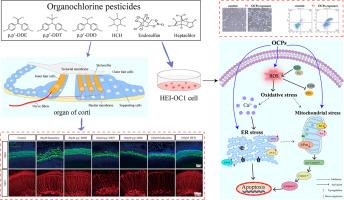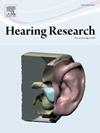六种有机氯农药对HEI-OC1细胞和小鼠耳蜗器官型培养物的耳毒性作用
IF 2.5
2区 医学
Q1 AUDIOLOGY & SPEECH-LANGUAGE PATHOLOGY
引用次数: 0
摘要
有机氯农药(ocp)是一种具有致突变和致癌风险的持久性污染物,对人类构成威胁,尽管其毒性已得到充分证明,但科学关注有限。我们的研究检查了六种常见的ocp (p,p ' -DDT, p,p ' -DDE, p,p ' -DDD,六氯环己烷,硫丹,七氯)的耳毒性,这些ocp经常在人类生物样本中被发现,包括血液和母乳。我们的研究结果表明,OCPs可引起出生第3天(P3)小鼠的耳蜗损伤,并在House Ear Institute-Organ of Corti 1 (HEI-OC1)细胞中表现出剂量依赖性的毒理学反应。OCPs暴露导致ROS (h2o2₂,O₂⁻,mtROS)的产生,钙超载,线粒体膜电位(MMP)降低,内质网(ER)应激激活。Western blot结果显示Bcl-2/Bax比值明显降低,cleaved caspase-9/3水平升高,内质网应激标志物(p-eIF2α、ATF6、GRP78、CHOP)升高。这些结果表明OCPs通过相互关联的途径诱导听觉细胞凋亡:氧化应激、线粒体功能障碍、钙调节失调和内质网应激。这项研究提供了ocp相关耳毒性的机制见解,强调了对这些普遍存在的环境毒素进行严格监管的必要性。本文章由计算机程序翻译,如有差异,请以英文原文为准。

Deciphering the ototoxic effects of six organochlorine pesticides on HEI-OC1 cells and mouse cochlear organotypic cultures
Organochlorine pesticides (OCPs), persistent pollutants with mutagenic and carcinogenic risks, that threatens humans, have received limited scientific attention despite their well-documented toxicity. Our study examined the ototoxicity of six prevalent OCPs (p,p’-DDT, p,p’-DDE, p,p’-DDD, Hexachlorocyclohexane, Endosulfan, Heptachlor) that are frequently identified in human biological samples, including blood and breast milk. Our findings revealed that OCPs caused cochlear damage in postnatal day 3 (P3) mice, and exhibited a dose-dependent toxicological response in House Ear Institute-Organ of Corti 1 (HEI-OC1) cells. OCPs exposure led to the generation of ROS (H₂O₂, O₂⁻, mtROS), calcium overload, mitochondrial membrane potential (MMP) decrease, and endoplasmic reticulum (ER) stress activation. Western blot showed a marked reduction in the Bcl-2/Bax ratio, an elevated level of cleaved caspase-9/3, and four increased ER stress markers (p-eIF2α, ATF6, GRP78, CHOP). These results suggest that OCPs induce auditory cell apoptosis through interconnected pathways: oxidative stress, mitochondrial dysfunction, calcium dysregulation, and ER stress. This study provides mechanistic insights into OCP-related ototoxicity, emphasizing the need for stringent regulation of these pervasive environmental toxins.
求助全文
通过发布文献求助,成功后即可免费获取论文全文。
去求助
来源期刊

Hearing Research
医学-耳鼻喉科学
CiteScore
5.30
自引率
14.30%
发文量
163
审稿时长
75 days
期刊介绍:
The aim of the journal is to provide a forum for papers concerned with basic peripheral and central auditory mechanisms. Emphasis is on experimental and clinical studies, but theoretical and methodological papers will also be considered. The journal publishes original research papers, review and mini- review articles, rapid communications, method/protocol and perspective articles.
Papers submitted should deal with auditory anatomy, physiology, psychophysics, imaging, modeling and behavioural studies in animals and humans, as well as hearing aids and cochlear implants. Papers dealing with the vestibular system are also considered for publication. Papers on comparative aspects of hearing and on effects of drugs and environmental contaminants on hearing function will also be considered. Clinical papers will be accepted when they contribute to the understanding of normal and pathological hearing functions.
 求助内容:
求助内容: 应助结果提醒方式:
应助结果提醒方式:


